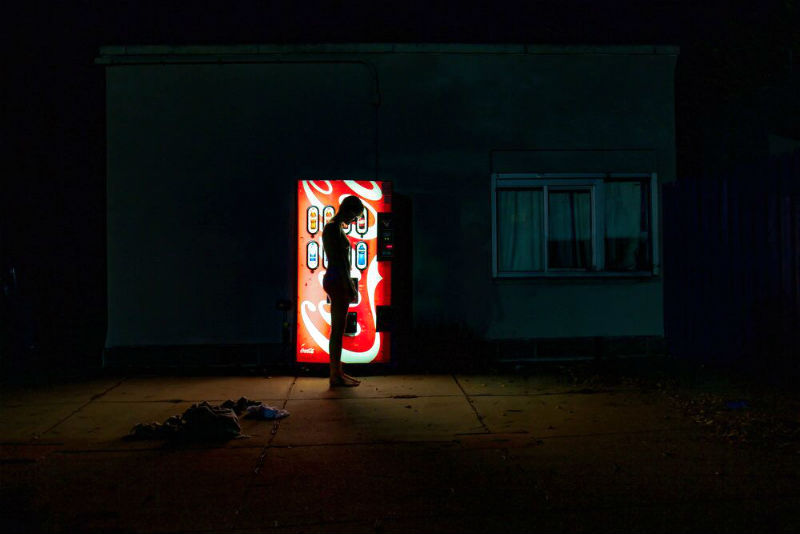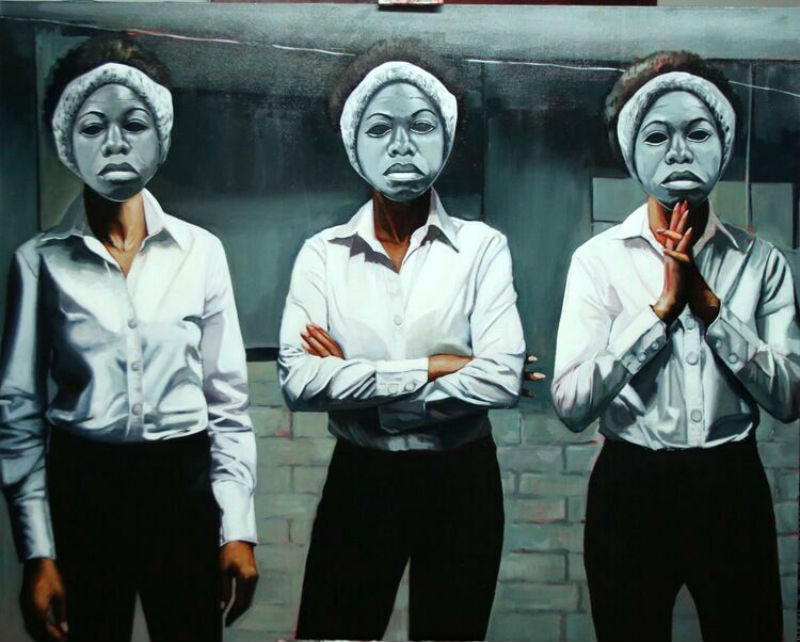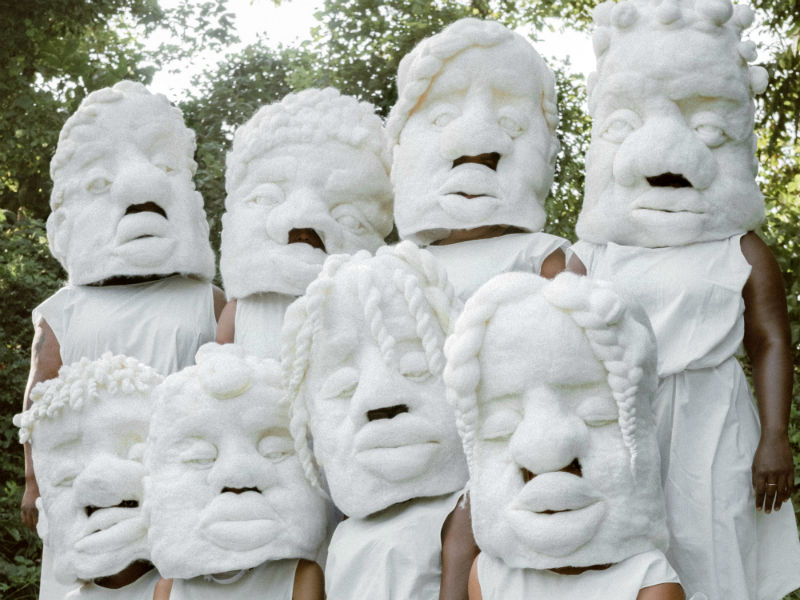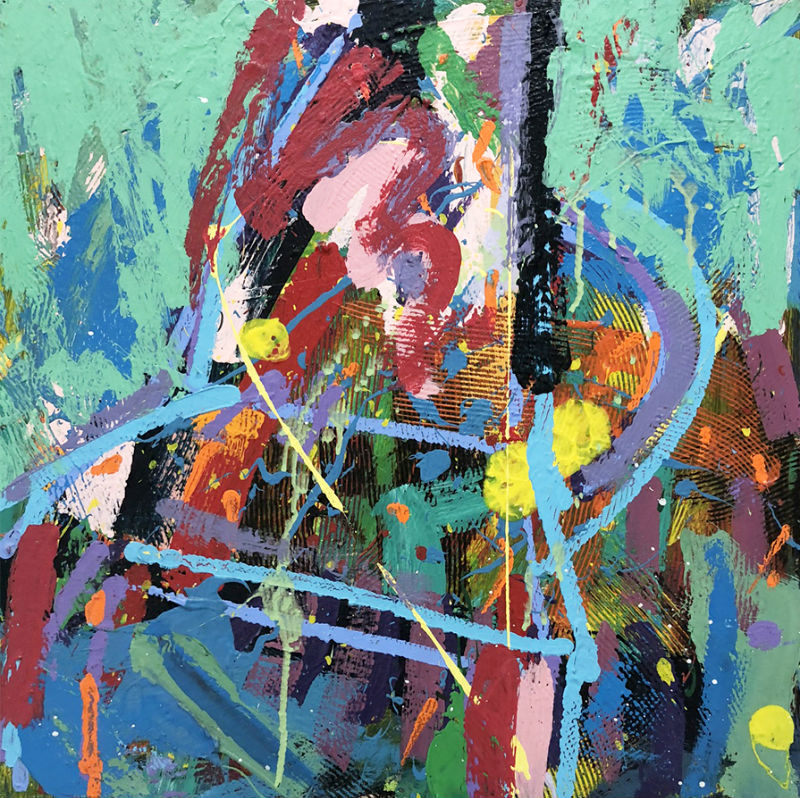Of Skin and Dirt: Ann Arbor Art Center's "Earthbody" explores the human frame's relationship to its habitat

The Ann Arbor Art Center’s Earthbody features works from 11 artists whose works explore, in some aspect, the relationship between the body and the environment. The exhibit focuses on works of current and recent students at the Penny W. Stamps School of Art & Design at the University of Michigan.
The Earthbody exhibition text is short and to the point: “How does our understanding of our bodies as earthly objects affect our ability to perceive and engage with the environment? Earthbody explores these relationships between body, self, and environment.”
As is typical of the group shows at the Art Center, there are a variety of approaches that engage with the subject of the exhibition. From imagery that appears grotesque or unsettling to those works portraying a sense of serenity, the artists pull from personal and shared histories to delve into the broad topics of the body and the environment.
Love and physics commingle in Theatre Nova’s “Stargazers”

Playwright Reina Hardy has a lot on her mind: the Big Bang Theory, the course of true love, the waxing and waning of sexual passion, personality disruptions caused by social media, the difficulty of making contact at a party when you’re socially awkward, and so much more.
These interests all come incongruously together in her play Stargazers, now having its Michigan premiere at Theatre Nova.
Three talented actors under the direction of David Wolber work hard to bring credibility to their characters and find the humor and a bit of poetry in Hardy’s cosmic drama. The play is a bit too artsy, the metaphors too forced, and the plot too thin. But the actors are engaging and in touch with the characters they play.
Roustabout Theatre Explores the Life and Works of The Bard in "Big Daddy Shakespeare"

Roustabout Theatre's Big Daddy Shakespeare looks at The Bard in a more personal and humanizing lens than is generally studied in school. A one-act play adapted from several of Shakespeare’s works by Anna Simmons and directed by Josie Lapczynski, shows him as a son, husband, and father who he left his young family to be a playwright in London. What was he thinking? Feeling? And how could his plays reflect his state of mind through separations -- and grief?
The Ypsi Experimental Space (YES) is decorated throughout with a specific theme. A popcorn machine greets you at the door, the warm scent of the freshly popped treat filling the air. Posters from past Roustabout Theatre shows are plastered on the walls like old circus playbills. The stage is draped in the unmistakable striped fabric of a circus tent.
The vehicles for our exploration of Shakespeare are, fittingly, four roustabouts, or circus workers who erect and dismantle tents, care for the grounds, and handle animals and equipment. Our four roustabouts (Amanda Buchalter, Julia Garlotte, Russ Schwartz, and Cynthia Szczesny) enter the stage to put up another poster (for the show we are about to see) and set up some stage equipment and costumes the circus might need, but are, of course, used for their own show.
Sonic Resistance in the Motor City: "Call & Response" at U-M's Penny W. Stamps Gallery

In keeping with recent exhibition themes at the Penny W. Stamps Gallery, its most recent show asks audiences to imagine a better future through the works of innovative and iconic contemporary artists.
Call & Response brings together diverse works and combines elements of the traditional exhibition space, a performance space, and a soundstage. Featuring the works of Romare Bearden, Chakaia Booker, Tony Cokes, Saffell Gardner, Allie McGhee, and Tylonn Sawyer, the gallery asks visitors to consider “sonic resistance in Detroit and beyond” through visual art, sound, and a restored historical stage from jazz-era Detroit. The central hub of the exhibition starts with the refurbished Blue Bird Inn stage and includes representational and abstract artworks responding to the cultural music scene of Detroit and beyond.
The glittering Blue Bird Inn stage was recently rescued from obscurity by Detroit Sound Conservancy. Opening in the late 1930s, the Inn was located on Tireman Street, Detroit’s “Jim Crow line.” In the 1940s, the bar’s owner, Clarence Eddins, used the space as a jazz club until the early 2000s. The exhibit notes that the stage is an “iconic example of African-American mid-century vernacular art and design,” and it's easy to imagine iconic musicians such as Miles Davis and John Coltrane standing on it and playing jazz to bustling audiences in Detroit.
Unmasking Herstory: Nastassja E. Swift's "she was here, once" at U-M's Lane Hall

Nastassja E. Swift wants to know what's behind the mask.
The Virginia-based artist's exhibit at Lane Hall, the home of the LSA Women’s Studies program at the University of Michigan, is part of a larger performance piece, titled she was here, once. Swift, in her artist statement, expands upon the intent behind her work:
Circling within conversations of marginalization, use of the black body and otherness, my work incorporates the idea of masking as a metaphorical tool to explore what it means to cover one’s face with another, questioning who’s being hidden and who’s being amplified. The mask themselves often acting as vessels of stories told through movement and in form, depicting the faces of our ancestral mothers as a way of demanding space for her and retrieving her power in the form of visibility of homage. Through fusing these larger-than-life size felted wool portraits with dance, I am able to shape experiences through storytelling and articulate self-identities in relation to ancestry.
Lane Hall’s gallery space is filled with various components of the project. Originally enacted by Swift and a group of eight women in the summer of 2018. The performance took place in Swift’s home city, Richmond, Virginia. First, the artist has suspended three of the large sculptural, white fiber masks worn and made by the women in the project from the ceiling in the main hall. Second, photographic stills from the initial performance line the walls of the gallery space. Finally, two television screens play both a mini-documentary and short film about Swift’s project on a loop.
Painting the Everyday: Sarah Innes' "Around the Table" at Ann Arbor Art Center focuses on the small moments in life

Ann Arbor artist Sarah Innes is a radical.
The fashion of the day in contemporary art is that we concern ourselves with the Big Issues: gender equality, climate change, gun violence, and the like.
Instead, Innes commits to painting only what she knows, deep in her bones.
She knows that life is precious and brief and consists of moments strung together like pearls on a necklace. She knows that children are born, make fun and mischief, move away. Parents, friends, colleagues, and significant others visit and dine, celebrate birthdays and anniversaries. Pets appear under the table and nestled in arms. Sometimes there is a death.
Around the Table, a small selection of her intimate paintings, is on view now at the Ann Arbor Art Center through July 23. Innes employs the image of the dining table, both as an organizing compositional device and as a metaphor for her life. Minute changes in the menu, changing seasons and an ever-mutating cast of characters provide a travelogue of her journey through time.
Chloe Gray’s Fun Girl dance company blends quirky movement with thoughtful activism in “Girlfriend”

On June 22 at Riverside Arts Center, I had the pleasure of attending the first show presented by Fun Girl, a new Ypsilanti-based contemporary dance company created and run by Artistic Director Chloe Gray. The company offers paid rehearsals and performances to their dancers, as well as apprenticeships, and acts as a platform for technically based dancers to explore quirky movement while applying thoughtful activism.
Artistic Director Chloe Gray’s credentials are extensive, with her training beginning at the age of 6 with the Toledo Ballet and continuing at the Toledo School for the Arts throughout her high school years. She graduated from Eastern Michigan University where she double majored in Dance Performance and Women’s and Gender Studies, and her choreography and dancing have been featured in performance opportunities through Kristi Faulkner Dance (Detroit), ARTLAB J Dance (Detroit), Koresh Dance Company (Philadelphia), and Side Street Art Studio (Chicago).
“I always thought that I was going to wait until I was older to start my own company,” says Gray. “My plan was to graduate from college, move to a big city to dance, and then eventually come back to Ypsi to plant some roots. Through careful consideration and after falling in love with a Michigander, I decided to stay in Ypsi and go for it. We have to create in places and spaces where the art we want to see does not exist. If we all take off to big cities, how will art exist in our community?”
The show, entitled Girlfriend, featured four original pieces choreographed by Gray and performed by Fun Girl, as well as four pieces that were chosen through the Ypsi Dance Swap organized by Gray in January, in which choreographers from across the state could submit their work to be performed in a show at Riverside Arts Center. Several of the choreographer’s pieces would then be chosen by a jury to be presented at Fun Girl’s Girlfriend recital in June.
What's Love Got to Do With It: The Purple Rose's comedy "Welcome to Paradise" offers a dreamlike romance -- or is it real at all?

In Julie Marino’s play Welcome to Paradise, a young man who has been backpacking through Europe helps an elderly woman who is having difficulty at the airport. Rory doesn’t just help Evelyn to her cab. He accompanies her to her beach house on the fictional Caribbean island of St. Sebastian, a beautiful spot in the middle of nowhere. Exhausted, he tries to find an inexpensive place to spend the night, but accommodations are costly in paradise. She invites him for the night.
He stays a good deal longer. He rearranges her flowers. He rearranges her furniture to better see the sunset from the couch. And just by being there, he rearranges her life.
In a detailed and nuanced performance, Ruth Crawford embodies Evelyn, at turns feisty and flirtatious, basking in the attention of an attractive fellow as young as her grandson who caters to her needs before she knows she has them. Ryan Black is a fine Rory, thoroughly at home in Evelyn’s home and life.
Minimalism & Maximalism: The National and Courtney Barnett at Hill Auditorium

"How does it feel to be the king of sad-dad rock?" shouted a fan last night at The National's lead singer, Matt Berninger, as he entered the Bell Tower Hotel in Ann Arbor.
The band had just finished a 25-song, two-hour set at the venue across the street, Hill Auditorium, which was filled to its 3,538 person capacity with sad dads (and moms) -- heretofore collectively known as SAD-D.A.M.
Berninger was joined by an augmented version of The National that added four additional musicians to the core quintet and they filled Hill with a massive wall of sound.
But the opening act, Courtney Barnett, achieved a similar feat with just herself on guitar plus a bassist and drummer -- and it was her second performance in Ann Arbor that day: at 12 noon, Barnett recorded an episode of the syndicated radio show Acoustic Cafe at The Leon Loft. (Check out a clip here.)
The abstract paintings of late Detroit artist Gilda Snowden are "Bold & Beautiful" at U-M's Connections Gallery

I will never meet Gilda Snowden.
I missed my chance when she died suddenly of heart failure on September 9, 2014, just as I was beginning to be dimly aware of her importance as an artist, an archivist of Detroit’s art scene, and a mentor to many of its young creatives. She left a large body of work behind, thousands of paintings and drawings, a few of which are currently on view at Bold & Beautiful at the University of Michigan’s Connections Gallery.
Snowden’s early work features bits and pieces from her collecting activities, collaged onto the surfaces of her paintings as opening gambits for her painting practice. She credited the influence of her Cass corridor mentors, who also worked in unconventional materials: leather, chainsaws, shotguns, barbed wire, and the like. By the time she produced the artworks represented in this exhibit, however, she had left those strategies behind for the more esoteric and protean qualities of pure paint.


































